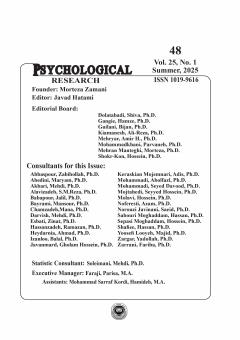About the journal
About us
Neevand Publishing was founded in 2009 with the aim of publishing valid books on psychology, psychiatry, education and related fields, and fortunately has been able to attract valuable and capable experts in this field and to publish more valuable books. Neevand publications hopes to take further and more effective steps in the advancement of psychology, psychiatry and education.
Address:
Floor 2nd,Numb 18
20th Street,First25th Street
after Hakim,Bridge27th West
Kurdistan Highway (north to south)
Tehran,Iran
FloorPostal code: 93553-14376
Email: research.psychological@gmail.com
Telegram Channel: https://t.me/neevandpub
Instagram Page: https://www.instagram.com/neevandpub.ir/
Phone call: 009821-88350858
Recent Articles
-
Open Access Article
1 - Investigating the Effectiveness of the Love City Game on Sexual Anxiety in Couples
Zahra Alizadeh ، saeed akbari zardkhaneh ، Soheila Sardari ، Jalil Fathabadi ، Soran Rajabi * ، mkn1372@gmail.com NajafiIssue 1 , Vol. 25 , Spring_Summer 2025 -
Open Access Article
2 - Life Skills Scale of Preschool Child-Parent Report (LSS-PPR): Development and Preliminary Psychometric Evaluation
saeed akbari zardkhaneh * ، Soheila Sardari ، Jalil FathabadiIssue 1 , Vol. 25 , Spring_Summer 2025 -
Open Access Article
3 - Relationship between Leader's Affective Capital and Organizational Health with Considering to the Mediating Role of Nurses’ Affective Capital
mehrdad jabbari ، mohsen golparvar *Issue 1 , Vol. 25 , Spring_Summer 2025 -
Open Access Article
4 - Investigating the Effect of Group Counseling based on Schema Therapy on the Cognitive Regulation of Emotions of Divorced Adolescents
farzaneh monjezi * ، Esmail Asadpour ، mosen rasouli ، Kianoosh ZahrakarIssue 1 , Vol. 25 , Spring_Summer 2025 -
Open Access Article
5 - Impact of Mental and Social Well-Being on Work-Family Overflow and Job Adjustment of Newly Employed Married Women
Hamideh Jafarzadeh * ، Mohammad hassani ، Hassan GhalavandiIssue 1 , Vol. 25 , Spring_Summer 2025 -
Open Access Article
6 - Relation of Job Design Approaches (Motivational and Mechanistic Models) with Job Satisfaction, Job Involve-ment and Organizational Commitment in a Set of Jobs
hajar barati * ، hamidreza oreyziIssue 1 , Vol. 25 , Spring_Summer 2025 -
Open Access Article
7 - Working Memory Impairment in Type 2 Diabetes: A Neurocognitive and Pathophysiological Review
Amir Reza Majidi ، abdolali ghavam ، Soghra Ebrahimi Ghavam ، Ehsan Rezayat *Issue 1 , Vol. 25 , Spring_Summer 2025 -
Open Access Article
8 - Factors Affecting Entry into Farhangian University and the Teaching Profession: A Case Study of Student Teachers
Mohammad Hasan Sharbatiyan ، Alireza Ghorbani *Issue 1 , Vol. 25 , Spring_Summer 2025
Most Viewed Articles
-
Open Access Article
1 - The Systematically Reviewing Studies Related to Academic Procrastination to Identify a Model and Theoretical Framework
mojtaba beyrami ، parvin kadivar * ، hadi keramati ، mehdi arabzadeh ، Javad KavousianIssue 1 , Vol. 24 , Spring_Summer 2023 -
Open Access Article
2 - Determining the Psychometric Properties and Measurement Invariance of The Couple Flourishing Measure
Manouchehr Rezaee ، Belal Izanloo * ، Naser Abbasi ، Habibeh Bashirnezhad dastjerdiIssue 1 , Vol. 24 , Spring_Summer 2023 -
Open Access Article
3 - The Effect Of Cognitive Rehabilitation of Inhibitory Control on Hot Executive Functions: Risky Decision Making and Time Perception in Children with Attention Deficit/Hyperactivity Disorder
Batool Najjari Alamooti ، Javid Peymani * ، Maryam Bahrami Hidaji ، Sheida Sodagar ، nahid Soomer havassiIssue 1 , Vol. 24 , Spring_Summer 2023 -
Open Access Article
4 - Reliability and Validity of the Short Form of the Reflective Function Questionnaire
Fatemeh Arab Ali doosti ، محمود دهقانی * ، maryam roshan ، somayeh robat miliIssue 1 , Vol. 24 , Spring_Summer 2023 -
Open Access Article
5 - Relationship Between Perceived Stress And Craving Usage with Predicting Relapse in Stimulants Users Mediated By Self-Control
roya jalili ، Javad KHalatbari * ، Hassan Ahadai ، shohreh ghorban shiroudiIssue 1 , Vol. 24 , Spring_Summer 2023 -
Open Access Article
6 - Examining the Reliability, Factor Structure and Criterion Validity of Marlowe-Crowne Social Desirability Scale
Alireza Azimpour * ، Tayebe Rahimi PordanjaniIssue 1 , Vol. 24 , Spring_Summer 2023 -
Open Access Article
7 - Effect of Career Construction Counseling on Qualitative Changes in the Future Career Autobiography of Students
parisa nilfrooshan * ، Sayyedeh Fatemeh MousaviIssue 1 , Vol. 24 , Spring_Summer 2023 -
Open Access Article
8 - Effectiveness of Schema-Therapy on Eating Styles Happy Child and Healthy Adults Modes in Obese People with Binge Eating Disorder: A Single-Case Study
Maryam Nourizadeh Mirabadi ، Marjan Hoseinzadeh Taghvaee ، Reza Moloodi * ، Sheida Sodagar ، Maryam Bahrami HidajiIssue 1 , Vol. 24 , Spring_Summer 2023 -
Open Access Article
9 - Ali Akbar Siassi, The Founder of Psychology in Iran: Biographical Introduction
Esmaeil Naseri *Issue 2 , Vol. 23 , Autumn_Winter 2021 -
Open Access Article
10 - Predicting Intimate Attitudes and Marital Happiness Based on self-Compassion and Communication Skills in Married female Students
Maryam Abedini * ، سامره اسدي مجره ، Solmaz Avarideh ، Abbas Mirblouk BozorgiIssue 2 , Vol. 23 , Autumn_Winter 2021







